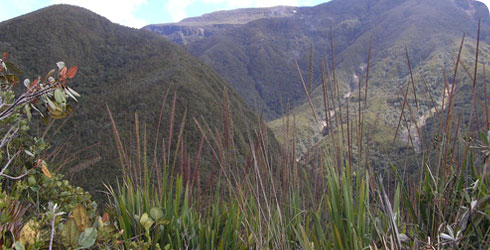Conservation
A range and conservation assessment follows, based on the assumption that I. donegani is endemic to Serranía de los Yariguíes, considering the number of Idioneurula specimens inspected from nearby regions.
The Yariguíes mountains attain suitable elevations for this species (over 3000m) with undisturbed habitat for c.25 km of their length and an average of c.1000m laterally (IGAC, 1995; IGAC, 1999), producing an estimated area of suitable habitat of 25 km2 for the new species.
We have insufficient data to determine a population estimate for I. donegani or population trends which are important for conservation assessments. However, the relative intactness and remoteness of habitats at high elevations in the Yariguies suggests that the population is unlikely to be declining by >30% over ten years (IUCN criterion A), nor that the habitat is "severely fragmented" (IUCN criterion B).
The inaccessibility of the new species' habitat, I. donegani's relative abundance where found and the protected status of the Serranía de los Yariguíes each give some hope for the species' long term conservation. However, I. donegani's apparently very small range, meaning that it would be likely to require categorisation as a threatened species, perhaps as Vulnerable.
Despite topographical difficulties and complexity of access, human pressure for agriculture and livestock are mounting issues. During the EBA and YARÉ expeditions, deforestation, hunting and anti-personnel landmines were observed, complicating conservation efforts.
Conservation of páramo habitats is clearly necessary for this species. In the YARÉ project, considerable conservation-oriented community work was carried out (see further in Huertas & Donegan 2006).
Deforestation and other threats could potentially be reduced through education programmes and encouraging treatment of páramos as water sources that should not be modified.
Subsequent to the EBA and YARÉ projects’ fieldwork and other important local input, Serranía de los Yariguíes was declared a National Park (Ministerio del Medio Ambiente, Desarrollo y Vivienda 2005), an Alliance for Zero Extinction site (Ricketts et al. 2005) and an Important Bird Area (AICA) (Franco & Bravo 2005). Additionally, Fundación ProAves has established a nature reserve in the region.
